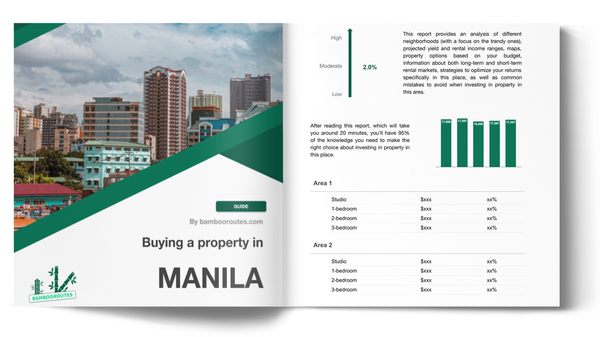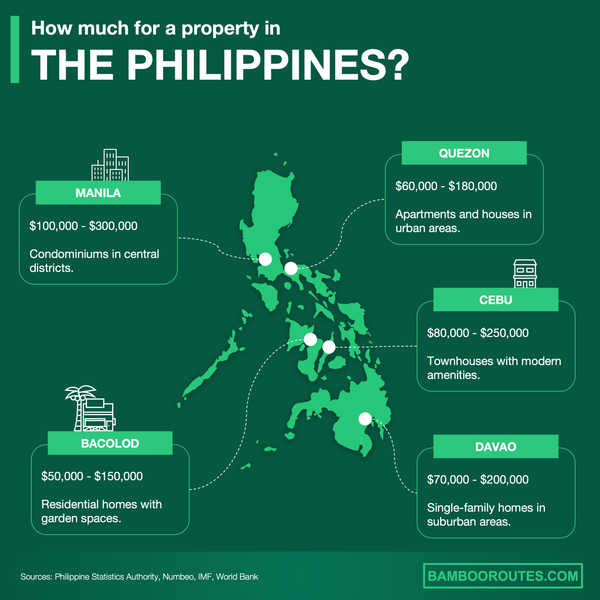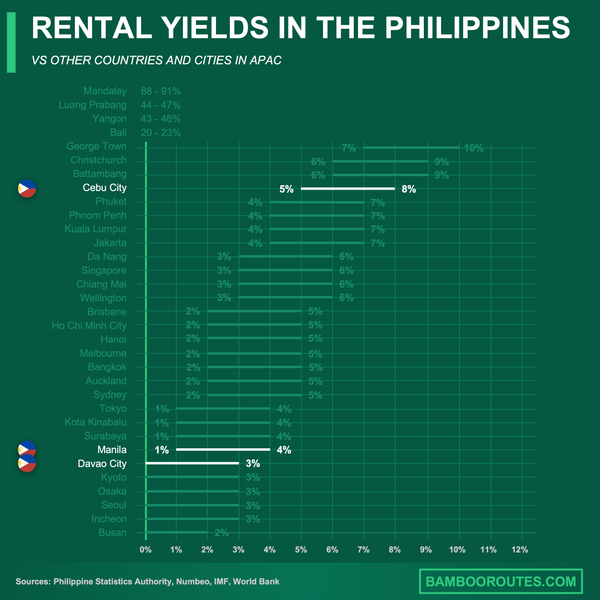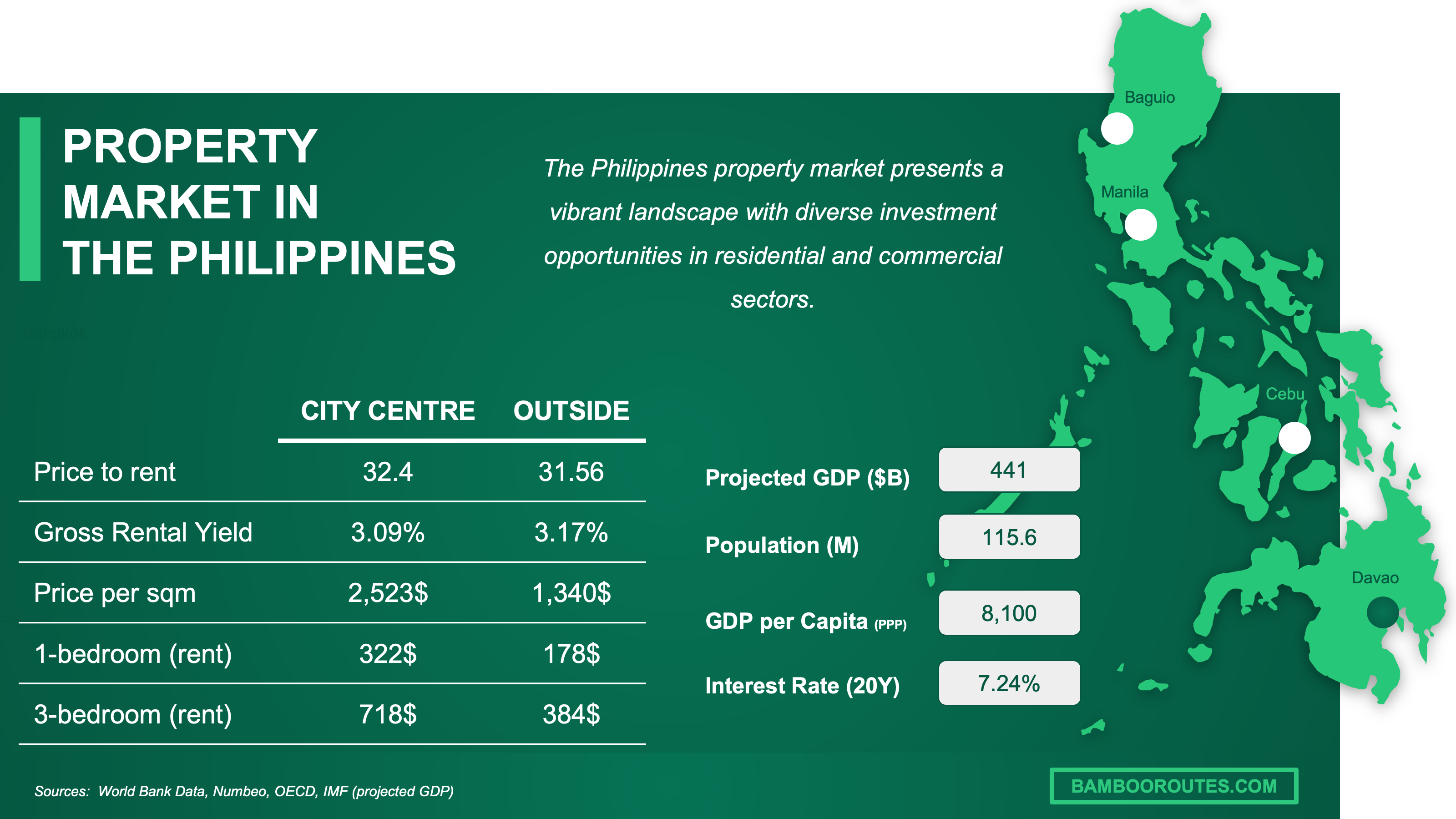Authored by the expert who managed and guided the team behind the Philippines Property Pack

Yes, the analysis of Manila's property market is included in our pack
What will happen in Manila’s real estate market? Will prices go up or down? Is Manila still a hotspot for foreign investors? How is the Philippine government impacting real estate policies and taxes in 2025?
We’re constantly asked these questions because we’re deeply involved in this market. Through our work with developers, real estate agents, and clients who buy properties in Manila, we’ve gained firsthand insights.
That’s why we created this article: to provide clear answers, insightful analysis, and a well-rounded perspective on market predictions and forecasts.
Our goal is simple: to ensure you feel informed and confident about the market without needing to look elsewhere. If you think we missed the mark or could do better, we’d love to hear your thoughts. Feel free to message us with your feedback or comments, and we’ll work hard to improve this content for you.

1) Chinese investors will keep focusing on Manila’s real estate, especially near business districts
Chinese investors are increasingly interested in Manila's real estate, especially near business districts.
Over the past few years, the number of Chinese nationals buying properties in Manila has surged. Back in 2019, inquiries about Philippine properties on Juwai.com reached a record high, with Manila being the top choice for Chinese buyers. This trend is fueled by the rise in business activities and investments by Chinese companies in the Philippines.
From 2010 to 2023, Chinese foreign direct investment in the Philippines skyrocketed, highlighting the country's strategic importance for Chinese firms. These investments include significant real estate ventures, supported by favorable government policies and the Philippines' involvement in initiatives like the Belt and Road Initiative.
Manila's proximity to China makes it a prime spot for Chinese investors compared to other Southeast Asian capitals. This geographical advantage, along with ongoing infrastructure projects in Manila, enhances connectivity and convenience, making it an attractive option for foreign investors.
Chinese companies are setting up offices in Manila's business districts, particularly in the offshore gaming sector. This has created a demand for real estate to accommodate their staff, further driving interest in the market. The presence of these companies is a testament to the growing economic ties between China and the Philippines.
With these factors in play, it's clear that Chinese interest in Manila's real estate market is set to continue, especially in areas close to business hubs.
Sources: Juwai News, AidData Report
2) Rental yields for high-end properties in Makati will drop because of oversupply
High-end properties in Makati are facing a tough market due to an oversupply of luxury units.
In 2024, around 3,500 new luxury units are expected to flood the market, adding to the already high inventory. This influx is causing a noticeable increase in vacancy rates, which hit 7.3% by the end of 2023. Even with 1,354 new prime units added in the last quarter of 2023, only 1,148 were rented out, showing a clear lag in demand.
Tenants are increasingly opting for more affordable areas, which is impacting rental yields for high-end properties. Property management surveys reveal that tenants are seeking cost-effective options, leading to a slight drop in rents for luxury segments in early 2023.
Real estate analysts warn of market saturation due to the increased supply of luxury condos. Emerging neighborhoods are now offering better rental yields compared to Makati's high-end areas, indicating a shift in tenant preferences.
These trends suggest that the high-end market in Makati is struggling to maintain its appeal. The oversupply and changing tenant preferences are creating a challenging environment for property owners.
Sources: Real Estate Asia, Global Property Guide

We created this infographic to give you a simple idea of how much it costs to buy property in different parts of the Philippines. As you can see, it breaks down price ranges and property types for popular cities in the country. We hope this makes it easier to explore your options and understand the market.
3) More foreign investors will focus on Manila's emerging neighborhoods for property investments
Foreign buyers are eyeing Manila's up-and-coming neighborhoods for investment opportunities.
With property prices in Manila's central business districts like Bonifacio Global City and Makati on the rise, emerging neighborhoods are becoming more appealing. As these central areas are expected to see a price increase of 3% to 7% by 2025, investors are on the hunt for more affordable spots with growth potential.
The Philippine government is stepping up its game by improving infrastructure, which is a big confidence booster for investors. This, combined with higher rental yields in less developed areas like Poblacion in Makati and Kapitolyo in Pasig City, where yields can hit 7-9% for smaller units, makes these neighborhoods attractive.
Foreign investors are increasingly interested in Southeast Asian real estate markets, including the Philippines, thanks to favorable economic conditions and government policies. Favorable exchange rates for foreign investors add to the allure of these emerging neighborhoods.
Sources: CEIC Data, Invest Asian, Filepino
4) Property price growth in Makati will slow as businesses move to other areas of Metro Manila
Makati's office vacancy rates have been on the rise, hitting 18.0% by the end of 2023 and expected to reach 20.5% in early 2024.
Businesses are increasingly looking beyond Makati, with many companies, especially BPOs, relocating to areas like Taguig City. This shift highlights a growing trend of businesses favoring other districts over Makati.
Infrastructure improvements, such as better roads and railways, have made commuting to other parts of Metro Manila more convenient. This has encouraged businesses to explore these areas as viable alternatives to Makati, spurred by new commercial and residential developments.
Historically, Makati's property prices saw a significant rise from 2010 to 2018, but growth slowed sharply in 2019. Meanwhile, Bonifacio Global City and Ortigas have emerged as attractive options for businesses and investors, offering better growth prospects.
These emerging business hubs are not just about convenience; they offer competitive advantages that Makati is struggling to match. The decentralization of businesses is a clear sign that Makati's dominance is being challenged.
As more companies move out, the competition for Makati is intensifying, with new developments in other areas drawing interest. This trend is reshaping the landscape of Metro Manila's business districts.
Sources: Real Estate Asia, Business Inquirer, Global Property Guide
5) Rental yields in Manila will rise as rental demand exceeds supply
Rental yields in Manila are on the rise as demand for rental properties continues to outstrip supply.
In recent years, rental prices in Metro Manila have consistently increased, with a 3.5% rise in 2023 following a 3.9% jump in 2022. This upward trend is a promising indicator for those considering property investments in the area. The bustling city life and economic opportunities in Manila are drawing more people, further fueling this demand.
The Philippines is experiencing a population boom, now at 119.1 million people, which is contributing to a significant housing shortage. As more people flock to urban centers like Manila, the need for rental properties is intensifying. This population surge is not just a number; it's a driving force behind the increasing rental demand.
Adding to the pressure is the slow pace of new housing developments. Despite the government's ambitious 4PH Program, which aims to build 1 million housing units annually until 2028, construction delays are prevalent. These delays mean fewer new homes are available, keeping the demand for existing rentals high.
For potential investors, this scenario presents an opportunity. With limited new housing and a growing population, the rental market in Manila is poised for continued growth. The city's vibrant lifestyle and economic prospects make it an attractive destination for many, ensuring a steady stream of renters.
In essence, the combination of rising rental prices, a booming population, and construction delays creates a perfect storm for increasing rental yields. Investing in Manila's rental market could be a savvy move for those looking to capitalize on these trends.
Sources: Global Property Guide, BusinessWorld Online, Tribune.net.ph
Make a profitable investment in Manila
Better information leads to better decisions. Save time and money. Download our guide.

6) Affordable housing projects will grow as government initiatives support low-cost residential development
In 2023 and 2024, the Philippine government made bold moves to boost affordable housing with the Pambansang Pabahay Para sa Pilipino Housing (4PH) Program.
This initiative aims to deliver 6 million affordable homes, with many projects already in progress nationwide. The government's increased budget and commitment are paving the way for more low-cost residential projects.
Partnerships with private developers are key to this effort. The Asian Development Bank (ADB) teamed up with Lhoopa, Inc. to support housing for average-income earners, bringing in both funds and expertise to enhance low-cost housing development.
The government is tackling a housing shortage expected to hit 6.5 million by 2030, aiming to reduce informal settlements. Programs like 4PH and ADB's collaboration with Lhoopa are central to this strategy, focusing on making affordable housing more accessible.
These initiatives are not just about numbers; they are about creating sustainable communities. The involvement of organizations like ADB ensures that these projects are not only affordable but also environmentally friendly, aligning with global sustainability goals.
With these efforts, the landscape of housing in the Philippines is set to change, offering more options for those seeking affordable living spaces.
Sources: BusinessWorld Online, Asian Development Bank
7) Demand for homes in Manila will rise as more overseas Filipino workers return
The return of overseas Filipino workers (OFWs) is set to significantly boost the demand for homes in Manila.
With remittances from the United States alone hitting $13.71 billion in 2023, OFWs have more cash to invest in real estate. From January to October 2024, these cash remittances saw a 3% increase, reaching $28.3 billion, further fueling their purchasing power.
Every month, around 900 distressed OFWs make their way back home, adding up to 26,994 from August 2022 to July 2024. This steady stream of returnees is a key driver of the housing demand as they look to settle back in the Philippines.
Government initiatives and banks are stepping up with affordable housing programs and flexible financing options. These efforts make it easier for OFWs to buy properties, thus pushing the demand even higher.
Sources: Statista, PPIE, Philstar, Trading Economics
8) Demand for homes with office spaces in Manila will grow as home-based businesses become more popular
In Manila, home-based businesses are booming, thanks to the rise of freelancing and the gig economy.
With more people working from home, the demand for properties with dedicated office spaces has skyrocketed. This is especially true in Metro Manila, where in 2023 and 2024, there was a 112% increase in demand for flexible workspaces compared to pre-pandemic times. The shift to hybrid work models has made having a home office not just a luxury, but a necessity.
In areas like the Makati central business district, the need for flexible office spaces is particularly high. People are looking for homes that allow them to work comfortably and efficiently, blending their personal and professional lives seamlessly.
Real estate market reports are showing a clear trend: properties with home office features are in demand. Even with some office space vacancies, the interest in homes that can double as workspaces is growing. This is a sign that people are prioritizing multifunctional living spaces.
Architectural trends are also shifting, focusing on creating multifunctional living areas that cater to the need for dedicated workspaces within homes. This aligns perfectly with the increasing demand for properties that support a work-from-home lifestyle.
Sources: BusinessWorld Online, Asia News Network, Philstar

We did some research and made this infographic to help you quickly compare rental yields of the major cities in the Philippines versus those in neighboring countries. It provides a clear view of how this country positions itself as a real estate investment destination, which might interest you if you’re planning to invest there.
9) Demand for pet-friendly homes will rise as more people adopt pets
In the Philippines, pet ownership has been on the rise, especially with dogs.
By 2023, 39.3% of Filipino households had a pet dog, marking a noticeable increase from the previous year. This trend is part of a larger movement across Asia, where the Philippines stands out with one of the highest rates of dog and cat ownership. As more people welcome pets into their homes, the demand for living spaces that accommodate these furry companions is growing.
Renters are increasingly looking for pet-friendly homes. By 2023, 59% of renters reported having at least one pet, up from 46% in 2019. This shift shows a strong preference for pet-friendly environments among those seeking rental properties. The real estate market has responded to this demand, with more listings highlighting pet-friendly features.
During the pandemic, pet ownership among renters surged, and this trend hasn't slowed down. In fact, twice as many potential renters used filters for pet-friendly listings than for any other amenity on platforms like Zillow. This underscores the high demand for homes that welcome pets, making it a key consideration for property buyers and investors.
Real estate agents have noticed that pet-friendly properties often attract more interest and can command higher rents. This is especially true in urban areas where outdoor space is limited, and pet owners are keen to find homes that offer suitable amenities for their animals. As a result, developers are increasingly incorporating pet-friendly features into new projects.
For those considering buying property in the country, understanding this trend can be beneficial. Investing in pet-friendly properties could offer a competitive edge in the market, as more people prioritize their pets' needs when choosing a home.
Sources: Statista, Multifamily Dive, Philstar.com
10) Demand for smaller, affordable units in Manila will rise as more young professionals move in
The growing number of young professionals in Manila is reshaping the real estate market.
In recent years, Manila has seen a surge of young adults entering the workforce, thanks to a robust job market. This influx is largely due to the city's vibrant lifestyle and abundant job opportunities, making it a magnet for young talent. As these professionals flock to the city, they are on the lookout for affordable living options that won't strain their budgets.
Faced with high living costs, many young professionals are opting for smaller, budget-friendly units. Co-living spaces have become a hit, offering economical solutions like MyTown’s bed spaces starting at just P4,000 a month. This setup is perfect for those who want to live close to work without spending a fortune.
Real estate developers are catching on to this trend, with companies like Ayala Land and SM rolling out projects aimed at young buyers. These developments focus on compact, affordable housing that meets the needs of this demographic. The strategic location of these units, often near business hubs and public transport, adds to their allure, providing convenience and easy access to both work and leisure.
Young professionals are not just looking for a place to stay; they want a lifestyle that fits their dynamic schedules. The proximity to business districts and entertainment spots is a big draw, as it allows them to balance work and play effortlessly. This shift in demand is prompting developers to rethink their strategies, focusing on creating spaces that cater to the modern urban dweller.
As the trend continues, the real estate market in Manila is likely to see more innovations in housing solutions, tailored to the needs of the young and ambitious. This evolution is not just about affordability; it's about offering a lifestyle that resonates with the aspirations of the city's new generation.
Sources: Philippine Statistics Authority, Philstar.com, SM Investments Corporation
11) Demand for luxury penthouses will decrease as buyers focus on practicality and affordability
Luxury penthouses in Manila are losing their charm as buyers focus on practicality and affordability.
In 2024, the price of luxury properties in Manila saw a 26% increase, making them less accessible for many. This surge is pushing potential buyers to reconsider their options, especially those who prioritize affordability. The demand for affordable housing is substantial, with a need for 6.7 million units as of December 2021, particularly in Metro Manila.
Buyers are increasingly drawn to practical housing options, reflecting a shift in consumer preferences. The sluggish condominium market further highlights this trend, as more people seek out affordable alternatives. Economic factors like high mortgage rates and elevated home prices have also made it tough for buyers to afford luxury properties.
Even though mortgage rates might drop in 2025, property prices are expected to stay high, continuing to steer buyers towards more affordable choices. The growing trend towards minimalist and sustainable living is also influencing this shift, as people embrace simplicity and practicality.
In Metro Manila, the unsold condo units reached 75,300 in Q3, indicating a slowdown in the luxury market. This aligns with the broader trend of buyers prioritizing affordability over luxury. The real estate market is evolving, and buyers are becoming more conscious of their spending, opting for homes that offer value for money.
As the market adapts, luxury penthouses may become less appealing, with buyers focusing on what truly matters: practicality and affordability.
Sources: SCMP, Statista, Manila Standard, Real.ph
Get fresh and reliable information about the market in Manila
Don't base significant investment decisions on outdated data. Get updated and accurate information with our guide.

12) Eco-friendly residential projects in Manila will grow as new tax incentives for green buildings are introduced
In Metro Manila, the real estate market is shifting towards sustainability as we move through 2023 and 2024.
Buyers are increasingly interested in properties with energy-efficient designs and renewable energy sources. This isn't just about personal preference; the government is also pushing for sustainable development with new regulations and incentives. These changes are making eco-friendly homes more appealing and accessible.
One major driver of this trend is the introduction of new tax incentives for green buildings. The Bangko Sentral ng Pilipinas (BSP) is leading the charge by offering a 15% single borrower limit on loans for sustainable projects and a zero percent reserve requirement rate for sustainable bonds until the end of 2025. These financial perks make it easier for developers to go green.
On top of that, the Philippine government is offering a seven-year corporate income tax holiday and tax exemptions for carbon credits from renewable energy sources. These incentives are a big deal for developers, making eco-friendly projects not just a good idea but a smart financial move.
Media coverage is also playing a role, highlighting the benefits of green buildings like lower utility costs and better marketability. This increased visibility, combined with financial incentives, is pushing developers to prioritize sustainable practices in their projects.
As a result, more developers are announcing new eco-friendly projects, reflecting the growing demand for sustainable properties in the market.
Sources: BusinessWorld Online, Bed and Go Inc., ASEAN Briefing
13) Interest in traditional single-family homes will drop as urban living becomes more popular
Urban living is becoming increasingly desirable in cities like Manila.
With Manila's population nearing 15 million by 2024, an influx of 274,900 people in just the past year is fueling the demand for city life. This surge is making urban living more attractive, especially in bustling areas.
Condominiums are gaining popularity in places like Metro Manila, Cebu, and Davao. These high-rise apartments offer a convenient lifestyle, combining living, working, and leisure all in one place. Surveys show people love the urban amenities and being close to work and fun activities.
In areas like Bonifacio Global City and Makati, property values are climbing due to limited housing and high demand. Meanwhile, single-family homes in the suburbs are seeing slower appreciation. New public transport and infrastructure projects are making city life even more appealing.
Younger folks are choosing to live near work and play rather than in bigger homes. This is driving up demand for tech-savvy, energy-efficient condos that cater to young professionals. Real estate investments are shifting towards urban properties to meet this demand for modern, eco-friendly living spaces.
Sources: BusinessWorld Online, World Population Review, Manila Times
14) Manila’s luxury property market will decline moderately as investors seek more affordable options
The luxury real estate market in Manila is experiencing a shift.
As of late 2024, 75,300 luxury condos in Metro Manila remain unsold, highlighting a significant inventory that isn't moving. This suggests that the demand for high-end properties is cooling off. While foreign investments in the Philippines are robust, there's no notable surge in luxury real estate investments in Manila. Legislative changes aimed at liberalizing economic policies might have led investors to diversify, steering away from luxury properties.
Interestingly, the broader housing market in the Philippines is on the rise, but the growth is more evident in the mid-range and affordable segments. For example, the residential real estate price index increased by 6.5% in 2023, which is slower compared to the growth in more budget-friendly housing options. This trend indicates a growing interest in affordable homes, as more buyers are looking for value rather than luxury.
In Manila, the luxury market's moderate decline is partly due to investors seeking more affordable options. The focus is shifting towards properties that offer better value for money, aligning with the broader trend of economic diversification. This shift is not just a local phenomenon but reflects a global trend where investors are becoming more cautious and selective about where they put their money.
For potential buyers, this means there might be opportunities to negotiate better deals on luxury properties. However, it's essential to consider the broader market dynamics and how they might affect property values in the long term. The current market conditions suggest that affordable and mid-range properties are gaining traction, offering a more stable investment opportunity.
As the market evolves, it's crucial to stay informed and adapt to the changing landscape. Whether you're looking for a luxury property or something more affordable, understanding these trends can help you make a more informed decision. The luxury real estate market in Manila is not disappearing, but it's certainly adapting to new economic realities.
Sources: Manila Standard, Shang Properties, Global Property Guide

We have made this infographic to give you a quick and clear snapshot of the property market in the Philippines. It highlights key facts like rental prices, yields, and property costs both in city centers and outside, so you can easily compare opportunities. We’ve done some research and also included useful insights about the country’s economy, like GDP, population, and interest rates, to help you understand the bigger picture.
15) Properties along the LRT-1 and MRT-7 routes will become more desirable due to their expansion
The expansion of the LRT-1 and MRT-7 lines in Manila is making properties along these routes more desirable.
When the MRT-3 line was developed, property values near the stations soared, showing how transit lines can boost real estate. This isn't just a Manila phenomenon; in Bangkok, land values shot up near mass transit stations, and Jakarta saw similar trends with planned transport hubs.
In areas like North Caloocan and Novaliches, the MRT-7 expansion is expected to drive up demand for both residential and commercial spaces. Big developers are already snapping up land along the route, betting on a surge in interest. This is a classic case of how improved accessibility can make certain locations prime investment spots.
Experts agree that properties in strategic locations, especially those with enhanced transport links, are wise investments. The pattern is clear: better public transport often leads to real estate booms, as seen in various cities across Asia.
For those considering buying property, the expansion of these transit lines offers a unique opportunity. As accessibility improves, the areas along these routes are likely to become more attractive to both residents and businesses.
Sources: BusinessWorld, Asian Development Bank, Housing Interactive
16) Property values in Malate and Ermita will rise due to the redevelopment of Manila Bay
The redevelopment of Manila Bay is poised to significantly boost property values in nearby areas like Malate and Ermita.
With a staggering P23 trillion investment in vertical property development, the Philippine Reclamation Authority is transforming the area into a hotspot for buyers and investors. This massive influx of capital is not just about new buildings; it's about creating a vibrant community that attracts people from all walks of life.
Historically, areas undergoing similar redevelopment have seen property prices soar. For example, property prices in Manila are expected to rise by 3% to 7% in 2025 compared to 2024. This trend indicates that as Manila Bay evolves, Malate and Ermita will likely experience a similar uptick in property values, making them attractive investment opportunities.
The government has greenlit several large-scale projects like Horizon Manila and Manila Waterfront City. These initiatives are set to enhance infrastructure and property values, with improved transportation links and new commercial and residential developments. This makes Malate and Ermita even more appealing for those looking to invest in prime real estate.
Insider knowledge suggests that these developments will not only improve the aesthetic appeal of the area but also increase its economic potential. The combination of new infrastructure and commercial spaces is expected to draw businesses and residents alike, further driving up property values.
As these projects progress, the demand for property in Malate and Ermita is likely to grow, driven by the area's enhanced appeal and strategic location. This makes it a prime time for potential buyers to consider investing in these neighborhoods.
Sources: BusinessWorld, Pear Anderson, BusinessWorld, Wikipedia
While this article provides thoughtful analysis and insights based on credible and carefully selected sources, it is not, and should never be considered, financial advice. We put significant effort into researching, aggregating, and analyzing data to present you with an informed perspective. However, every analysis reflects subjective choices, such as the selection of sources and methodologies, and no single piece can encompass the full complexity of the market. Always conduct your own research, seek professional advice, and make decisions based on your own judgment. Any financial risks or losses remain your responsibility.
